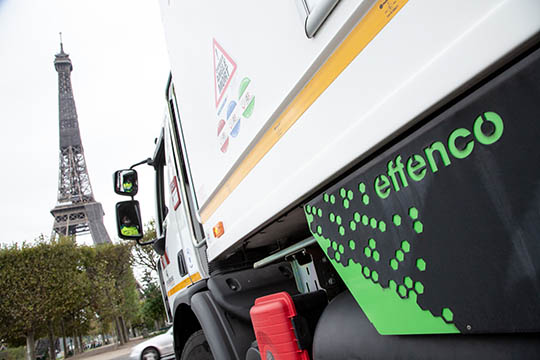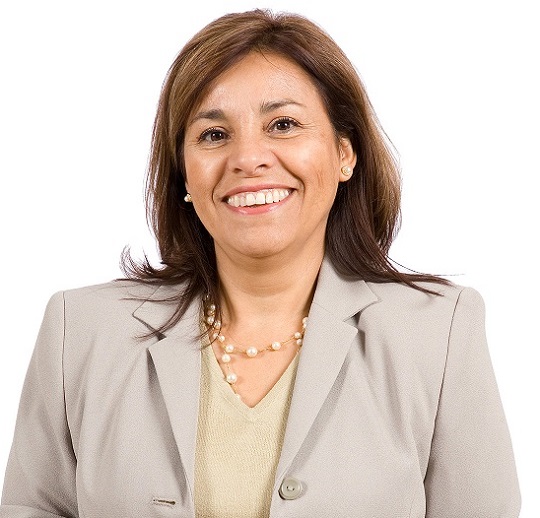Some of the most essential commercial vehicles—workhorses that play a crucial role in construction and infrastructure worldwide—are responsible for contributing upwards of 20% of all transportation-related greenhouse gas (GHG) emissions. Thankfully, companies like Effenco Development Inc. have engineered highly effective cleantech solutions to dramatically reduce their environmental impacts.
“Our early R&D years were driven by a two-part, win-win strategy: Providing operational savings and reducing GHG emissions,” recalls David Arsenault, President of Montreal-based Effenco. The company provides both hybrid-electric and 100% electric solutions for heavy-duty vocational vehicles, including terminal tractors, waste collection trucks and dump trucks.
With Effenco’s hybrid technology onboard, which includes innovative electrical systems and rechargeable batteries, fuel consumption and engine hours can be significantly reduced—substantially decreasing operational and maintenance costs.
Add to these benefits, a 20% to 35% reduction in GHG emissions—not to mention unwanted noise pollution—and you’ve got a clean and compelling solution for fleet managers across the globe. In fact, it’s the most cost-effective electrification solution in terms of dollars per ton of CO2 emissions avoided.
Today, Effenco’s hybrid solution is used in more than 400 trucks in 10 countries around the world. Although they’ve found traction in Canada, 90% of their sales come from international markets—primarily the United States and Europe.
Vocational vehicles are part of a global market worth an estimated $200 billion and Effenco is poised to take on a bigger chunk of that business. They’ve doubled their team in the last two years just to keep up with the rising global demand for their patented technology. Along the way, they’ve garnered impressive accolades, including the Solar Impulse Efficient Solution Label and being named to the 2021 Global Cleantech 100 by Cleantech Group for their sustainable innovation.
A major sign of a company’s maturity is their adoption of FX contracts as a risk mitigation tool. If you try natural hedging and your timing’s off, your profit margins can be completely wiped out by currency fluctuations.
Currency challenges
As with many small exporting companies, Effenco has a long order-to-cash cycle with their global customers, coupled with a significant lead-time requirement from their supply chain in China. Managing the foreign exchange (FX) risk that exists between the time a contract price is quoted and the day it’s settled is one of their key challenges, especially given the current level of market volatility and shifting currency conversion rates.
“In the past, we’ve tried to do whatever natural hedging we could by using the receipts of funds we had to offset the expenses. We didn't always get the CAD, USD, Euro or Renminbi when we needed them, so we typically ended up dipping into the market at spot rates to buy whatever countervailing currency was required,” says Shaun Parmar, Effenco’s Chief Financial Officer.
It’s not an ideal solution for any growing company—even the experts can’t predict how exchange rates will evolve. And when you consider that Effenco might experience a two-year lapse between the time they price a contract in a foreign currency, and the day they need to convert funds, that’s a considerable amount of risk to take on. But there’s a simple solution: FX forward contracts.
You should also check out
Download our FX hedging strategy guide to learn more about this and other FX instruments.
According to Luis Torres, EDC’s account manager for Effenco, “A major sign of a company’s maturity is their adoption of FX contracts as a risk mitigation tool. If you try natural hedging and your timing’s off, your profit margins can be completely wiped out by currency fluctuations.”
How exchange-rate fluctuations can take a bite out of profit margins
On the sell side
Let’s say you have a contract with a customer in the U.S. worth US$300,000. At the time of sale, the exchange rate is 0.9375, so you’re expecting to be paid C$320,000. But at the time of settlement, the exchange rate is 0.9920, so now you’ll only be paid C$302,419.
Your loss: C$17,581.
On the buy side
Let’s say you have a contract with an Australian supplier worth AUD$300,000. At the time of sale, the exchange rate is 1.0705, so you’re expecting to pay C$280,243. But at the time of settlement, the exchange rate is 1.0065, so now, you’ll have to pay C$298,063.
Your loss: C$17,820.
Guaranteed win-win
Effenco knew they needed to protect both their foreign costs and sales from exchange rate fluctuations. They also wanted to be able to price their products competitively and have confidence that their revenue forecasts wouldn’t fall short due to currency volatility. That’s when they turned to their financial institution (FI) for help in managing their FX exposure. Their FI suggested getting Export Development Canada (EDC) involved, requesting a Foreign Exchange Facility Guarantee (FXG) be put in place to eliminate the FI’s exposure.

Understandably, FIs need to cover themselves in the event that their customer isn’t able to execute on a contract. They often do this by freezing a portion of the company’s line of credit to use as collateral, should that company default on paying off their FX hedging instrument. FX providers typically charge about 10% of the total value of the FX contract. For a business, like Effenco—with suppliers in China and buyers in the U.S. and Europe—that’s a large amount of cash to have sitting on the sidelines. It’s a situation that can prevent a fast-growth company from pursuing new opportunities when they present themselves.
This is why FX providers count on EDC: With an FXG in place, they’re 100% guaranteed. It’s a win-win for businesses and their FX providers, with the twin virtues of freeing up the collateral requirement and locking in currency rates in advance. In essence, EDC’s FXG is a 100% irrevocable and unconditional guarantee that’s issued to the FX provider in place of a margin facility and is typically set for a one-year period. The foreign exchange contracts that are supported under an FXG can also be extended up to three years.
It’s a perfect solution for Effenco. “Our FX line lets us lock in a rate for any one of the currencies we deal in, without actually having to deliver on it. And then, depending on whether we actually need the funds or not, we can swap them out for another time period. It really comes in handy from a hedging point of view,” says Parmar.
From a growth perspective, eliminating the collateral requirement means companies can use their full working capital line to foster new opportunities, rather than secure existing ones.
“It might seem like an obvious solution,” adds Torres, “but most small companies don’t know about it. And even medium-sized businesses don’t always optimize their FX hedging strategies as effectively as they could.” He says by eliminating the customer’s collateral requirement, an EDC FXG can help to increase their borrowing capacity because now that you have more working capital, your FI may be willing to lend you additional funds.
You should also check out
Download our FX guide to learn how to better protect your profit margins while positioning your business for growth.
Every company needs to come up with their own FX hedging ratio based on the amount of risk they’re willing to take on. Ideally, this is a decision made only after a formal measurement of exposure to FX risk has been done. You can then work with your FX provider to determine the total amount of future contracts required for any given year, who will then work directly with EDC to put a guarantee in place. It’s fast, it’s affordable—and in these days of extreme volatility—it’s an essential tool to help support your international growth.
5 things you need to know about FXG
Never finalize a foreign contract without considering what currency fluctuations could do to your bottom line. If you’re talking to your FX provider about managing your FX exposure, make sure an EDC Foreign Exchange Facility Guarantee (FXG) is part of that conversation. Here are some of the key benefits:
- Predictable: During periods of extreme volatility where currencies can fluctuate wildly, you’ll have the comfort of knowing your rates have been locked in—both buying and selling. You can factor this into your pricing, ensuring not only your profit margins, but more accurate revenue forecasts overall.
- Improves cash flow and credit position: Because an FXG eliminates your FX provider’s need to secure collateral, you’ll have access to your full credit line and likely obtain additional financing if needed due to your enhanced creditworthiness.
- Flexible timing: Your FXG coverage doesn’t have to be in place at all times throughout the life of your contract. Instead, it can be initiated part-way, as needed, and as the deal progresses.
- Customized coverage: The percentage of coverage can be tailored to support either a portion of, or your total FX risk, making it a flexible solution tailored to your specific needs and risk tolerance.
- Works for companies exporting directly or indirectly from Canada with foreign suppliers: Even if you’re not hedging your sales, you might be importing product inputs or machinery, so you’re still subject to FX risk on those costs. EDC’s FXG solution can work for you in these circumstances.



